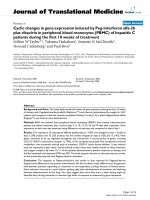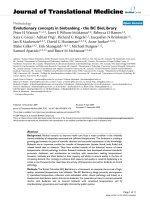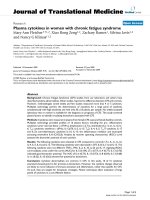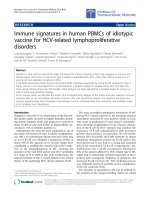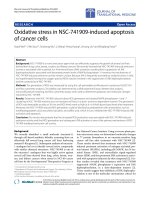Báo cáo hóa học: " Alcohol-related hypoglycemia in rural Uganda: socioeconomic and physiologic contrasts" doc
Bạn đang xem bản rút gọn của tài liệu. Xem và tải ngay bản đầy đủ của tài liệu tại đây (157.32 KB, 4 trang )
BRI E F RE S E A R CH REPOR T Open Access
Alcohol-related hypoglycemia in rural Uganda:
socioeconomic and physiologic contrasts
Heather Hammerstedt
1,5*
, Stacey L Chamberlain
2,5
, Sara W Nelson
3,5
, Mark C Bisanzo
4,5
Abstract
Hypoglycemia is a rare but important complication seen in patients who present with alcohol intoxication. In a
study by Marks and Teale, less than one percent of people with alcohol intoxication who presented to an
American emergency department were hypoglycemic [1]. It is even more rare to see an intoxicated patient, who
had been eating appropriately prior to or during the intoxication, present in a hypoglycemic coma. However, our
analysis of the first 500 patients seen in a newly opened five-bed Emergency Department (ED) at Nyakibale Karoli
Lwanga Hospital in rural southwestern Uganda, revealed multiple intoxicated patients who presented in
hypoglycemic coma within hours of eating a full meal. Three of these cases are summarized and discussed below.
Case One
A 32-year-old man wa s found confused and moaning in
bedbyfamilyat5a.m.,andbroughtinbyfamilyat9a.
m. Family members stated he had eaten lunch and din-
ner with them the previous day, then went out drinking
alcohol with friends and came home at 3 a.m. Past med-
ical and surgical histories were unremarkable, and he
takes no medications and has no allergies.
On examination, his vital signs were stable (blood
pressure 110/70 mmHg, heart rate 68 bpm, respiratory
rate 12 bpm, oxygen saturation 93% room air, tempera-
ture 37°C), and the patient was unresponsive. He
responded to sternal rub with moaning and moved all
his extremities to painful stimuli. He smelled of sweet
alcohol and did not answer questions. His eyes were
open, pupils were reactive, and his head was normoce-
phalic and atraumatic. He had no meningismus and no
clonus. Cardiopulmonary and gastrointestinal examina-
tions were normal, and he had no signs of trauma. A
fingerstick point of care test indicated that the concen-
tration of glucose in his blood was 27 mg/dl.
The patient was given 30 ml of D50W, awoke imme-
diately, jovial and smiling, and was observed for 1 h.
While getting 500 ml of D5W, he ate some food,
remained normoglycemic, and then was discharged. He
did not return within 1 month. His diagnosis was alco-
hol-related hypoglycemia.
Case Two
A 50-year-old man, known to be an alcoholic, presented
after being found unresponsive at home in bed. He had
been drinking the night before, but his family members
could not arouse him in the morni ng. He had eaten a ll
three meals the day and night before. Further history
elucidated that he had had a cough for 1 month and 2
days o f epigastric pain without vomiting, hematochezia,
or diarrhea. He had no remarkable medical or surgical
history, took no medications, and had no known drug
allergies.
His examination demonstrated a disheveled man who
appeared unresponsive with only gurgling respirations
(temperature 34.3°C, pulse 96, blood pressure 90/50,
respiratory rate 20, oxygen saturation, 86% room air).
He had no signs of trauma. His pupils were reactive and
equal. He moved all extremities to painful stimuli and
sternal rub, and his cardiopulmonary exam ination was
normal. He had no meningismus and no clonus. His
abdominal examination revealed epigastric guarding.
There was no gross blood on rectal examination. His
blood glucose concentration was 19.8 mg/dl as deter-
mined by a fingerstick. A chest x-ray was obtained
because of hypoxia and demonstrated a possible left
lower lobe infiltrate.
The patient was given 25 ml of D50W and 500 ml of
D5W. He awoke rapidly, and the results of his neurolo-
gic examination were normal, but he remained
hypothermic and hypoxic with epigastric guarding. He
was given oral omeprazole (as only oral prot on pump
* Correspondence:
1
Idaho Emergency Physicians, Boise Idaho, USA.
Full list of author information is available at the end of the article
Hammerstedt et al. International Journal of Emergency Medicine 2011, 4:5
/>© 2011 Hammerstedt et al; licensee Springer. This is an Open Access article distributed under the terms of the Creative Commons
Attribution License (http://crea tivecommons.org/licenses/by/2 .0), which permits unrestricted use, distribution, and reprod uction in
any medium, provided the origina l work is properly cited.
inhibitors are available in Uganda), IV ranitidine, and IV
ceftriaxone, and placed on an oxygen conc entr ator. The
next day, the patient improved and was normothermic
and normotensive, with normal oxygen saturation, a nd
with normal abdominal and cardiopulmonary examina-
tion results. The patient was discharged with the diag-
nosis of alcohol-related hypoglycemia, gastritis, and
aspiration pneumonia. He declined prescriptions for
proton pump inhibitors or antibiotics on discharge. He
did not return within 1 month.
Case Three
A 55-year-old female presented to the ED after being
found unresponsive in bed by friends in the morning.
She was last seen by her neighbors the night before
when they ate dinner together. Her neighbor stated that
the patient does not regularly consume alcohol. Her
past medical history was signi ficant only for peptic ulcer
disease, but she was not currently taking any me dica-
tions. She had no known drug allergies.
Examination revealed a well-nourished, hemodynami-
cally stable (temperature 37°C, pulse 113, blood pressure
152/98, oxygen saturation 95% room air), non-toxic,
unresponsive female. She withdrew all extremities to
painful stimuli, and had no clonus and no meningismus.
She had no signs of traumatic injuries; her pupils were
reactive, and her cardiopulmonary and gastrointestinal
examinations were normal. The blood glucose concen-
tration, as determined by fingerstick, was 32 mg/dl.
The patient received 15 ml of D50, improved immedi-
ately to a normal mental status, and had normal neuro-
logic e xamination results. The patient reported that she
had been drinking large quantities of alcohol, but she
had eaten all her meals yesterday. The patient was
admitted to the ward. She continued to be alert and
oriented, and was discharged the next day. She did not
return within 1 month. Her diagnosis was alcohol-
related hypoglycemia.
Discussion
In the United States, alcoholic patients who present with
a depressed mental status are usually not in a hypogly-
cemic coma, but instead have other etiologies of coma
such as sepsis, shock, hypothermia, trauma, or excessive
intoxication. Those who do present in a hypoglycemic
coma usually are an exception to this ‘rule’ and fit into
a few clinical stereotypes. Most have had a prolonged
calorie fast (greater than 24 h) in the setting of an
extended alcoholic binge or have a fasting state of sev-
eral days with a more moderate amount of alcohol
ingestion [2-4]. Additionally, these patients are usually
abstaining from alcohol by the time of presentation [5].
Also, in the US, it is rare for non-diabetic pat ients to
present with hypoglycemia; in one study over an 8-year
period, only 88 patients were admitted to a tertiary care
hospital with hypoglycemi a, and of these, alcohol intoxi-
cation was found in only 13 patients (15%) [6]. Our
Ugandan patients seem to differ from US patients in
that it was common to observe non-diabetic patients
presenting with hypogly cemia; also, the Ugandan alco-
holic patients did not fit into any of the ‘exceptions’
noted abov e as there was no fasting state, and they pre-
sented after acute alcohol ingestions without a signifi-
cant period of abstinence.
To under stand this, it is necessary to review the basic
pathophysiology of glucose utilization [7]. In the post-
prandial state, insulin levels peak at about 1 h and then
steadily fall over the next several hours. Simultaneously
during this decline, there is decreased uptake of glucose
by the liver, muscle, and adipose tissue. Insulin is no
longer suppressing glycogenolysis, gluconeogenesis, and
lipolysis. For the first 12-24 h of fasting, hepatic glyco-
genolysis provides most of the glucose from glycogen
stores. After that, lipolysis and protein breakdown pro-
vide fatty acid for energy, and glycerol and amino acids
for gluconeogenesis. Therefore, assuming that a person
is eating adequately at regular intervals, hypoglycemia
can be avoided through various back-up mechanisms.
Alcohol affects this process however. When ethanol is
metabolized in the liver by alcohol dehydrogenase to
acetaldehyde, it reduces nicotinamide adenine dinucleo-
tide (NAD) to NADH. In the nex t step in the pathway
of ethanol breakdown, acetaldehyde is metabolized by
aldehyde dehydrogenase, which also reduces NAD to
NADH and produces acetate, which leaves the liver for
metabolism by extra-hepatic tissue, such as skeletal
muscle. Thus, the process of alcohol metabolism signifi-
cantly decreases the hepatic NAD/NADH ratio. In rats,
where the e ffect of ethanol on the hepatic re dox state
has been determined by freeze-clamping the live r, this
ratio changes rapidly from 700/1 to 200/1 [8]. This
change in hepatic redox state has profound ef fects on
metabolic processes in the liver, since both alcohol
metabolism and gluconeogenesis occur in this tissue,
and both metabolic processes alter the NAD/NADH
ratio.
Gluconeogenesis requires a specific NAD/NADH ratio
for the reductive synthesis of glucose [9]. Elevated levels
of NADH, such as occur during ethanol metabolism,
negatively affect a number of critical dehydrogenases in
the l iver that are required for gluconeogenesis [10]. For
example, the conversion of lactate to pyruvate ( a key
gluconeoge nic step) will be strongly inhibited by the
increased level of NADH caused by the oxidation of
ethanol. In addition, malate conversion to oxalacetate by
NAD malate dehydrogenase, which is a critical reaction
in gluconeogenesis, will be inhibite d by the high level of
cytosolic NADH. Alanine is another key gluconeogenic
Hammerstedt et al. International Journal of Emergency Medicine 2011, 4:5
/>Page 2 of 4
intermediate whose metabolism is profoundly altered by
ethanol oxidation. Alanine is converted to pyruvate in
the liver by alanine aminotransferase, but the elevated
levels of NADH ensure that pyruvate will be immedi-
ately converted to lactate by lactate dehydrogenase.
Thus, ethanol consumption rapidly increases the blood
lactate concentration, while decreasing the level of glu-
cose. Ethanol also can redistribute pancreatic microcir-
culation to enhance late-phase insulin secretion. This
can cause hypoglycemia directly and inhibit the release
and activation of counter-regulatory corticotropin , corti-
sol, and growth hormone that normally counteract
hypoglycemia, which increases the risk for reactive
hypoglycemia [11].
The hepatic redox sta te, however, should not affect
the other processes of glycogenolysis and lipolysis, the
other two major s ources of glucose and energy other
than gluconeogenesis. So why would our intoxicated
Ugandan patients present with hypoglycemia despite
normal feeding patterns when the US patients do not?
Both lipolytic and ketogenic pathways are important to
prevent hypoglycemia by providing substrates, free fatty
acids, and ketone bodies, for alternative energy sources.
If levels of fatty acids or ketone bodies fail to increase
during fasting, the risk of hypoglycemia increases. The
Ugandan diet is mostly carbohydrate starch from
matoke (boiled mashed banana) and cassava, with a
small amount of protein intake from beans and legumes.
The impoverished low socioeconomic rural population
that we serve in our hospital does not typically have
access to a more varied diet. Patients commonly demon-
strate kwashiorkor (protein deficie ncy) and marasmus
(combined protein and carbohydrate deficiency) syn-
dromes. It is possible that due to this chronic malnutri-
tion, they lack the appropriate hepatic and muscle
glycogen reserves that would be required to maintain
normal blood glucose levels after even a brief fast com-
bined with alcohol consumption [12].
Chronic malnutrition also decreases the availability of
triglyceride in adipose tissue, which results in deficient
glycerol available to be converted to glucose and fewer
fatty acids to support energy metabolism. The average
weight of an adult man in our ED is approximatel y 50
kg. These patients would then not only have gluconeo-
genesis limited by alcohol metabolism (as our US alco-
holic population does as well), but they also have an
inability to back up glucose stores with appropriate gly-
cogenolysis and lipolysis. Despite only a short fast, in
this baseline malnourished state, the normal metabolic
mechanisms, such as mobilization of hepatic glycogen
and fatty acid from adipose, would be insufficient to
maintain energy homeostasis in the face of an ethanol-
induced decrease in hepatic gluconeogenesis.
Many other factors could be involved in this process
as well. Furth er research should be undertaken to inves-
tigate the possibility of a genetic difference in the rate of
clearance of ethanol (which could maintain the reduced
hepatic redox state longer than expected). Perhaps the
type of alcohol (or its processing) could play a role as
well. Most of the rural population in this area drinks
homemade sorghum or banana alcohol instead of other
commercial grain alcohols or beers seen in more socioe-
conomically sound communities in high income coun-
tries. A less likely t heory would be a frank baseline
NAD deficiency due to genetics or malnutrition, but
one would expect a more global effect on health rather
than just alcohol-induced hypoglycemic coma. Little
information exists on alcohol-related hypoglycemia in
low-income countries, although hypoglycemia was com-
monly found in one recent study of alcoholic Nigerians
[13].
Conclusion
Socioeconomic factors in low and middle income coun-
tries clearly affect clinical scena rios in many ways, from
higher infectious disease prevalence and an increasing
proportion of chronic dise ase, to the fina ncia l and cul-
tural barriers to access of care. As demonstrated in this
case series, it seems that socioeconomic factors may also
play a large role in affecting the clinical presentations of
patients because of their effect on basic science patho-
physiology. Alcohol-induced hypoglycemia may be only
one example of this phenomenon; further research
should be done to elucidate how these factors ca n affect
other basic pathophysiologic processes.
Consent
Verbal consent was obtai ned by the patients for publica-
tion of this case report, with ‘written’ thumb print as
signature due to language barrier and high rates of illit-
eracy. These consents are at Karoli Lwanga Nyakibale
Hospital in Rukungiri District, Uganda. Research
approval was obtained by the Medical Superintendent of
the hospital.
Acknowledgements
• Financial support from donations to Global Emergency Care Collaborative
(), a 501c3 nongovernmental
organization.
• Editing support from Professor Richard Hanson, PhD, Department of
Biochemistry, Case Western Reserve University, Cleveland, Ohio.
All authors are founding members of the 501c3 nonprofit organization,
Global Emergency Care Collaborative.
Author details
1
Idaho Emergency Physicians, Boise Idaho, USA.
2
Department of Emergency
Medicine, University of Illinois at Chicago, Chicago Illinois, USA.
3
Department
of Emergency Medicine, Maine Medical Center, Portland Maine, USA.
4
Department of Traumatology and Emergency Medicine, University of
Hammerstedt et al. International Journal of Emergency Medicine 2011, 4:5
/>Page 3 of 4
Connecticut, Hartford Connecticut, USA.
5
Global Emergency Care
Collaborative.
Authors’ contributions
HH and SC participated in clinical care of all case studies. HH was primary
author. SC, SN, MB were secondary authors and editors. All authors read and
approved the final manuscript.
Competing interests
The authors declare that they have no competing interests.
Received: 2 July 2010 Accepted: 10 February 2011
Published: 10 February 2011
References
1. Marks V, Teale JD: Drug induced hypoglycemia. Endocrinology Metab Clin
North Am 1999, 28:555-577.
2. Duffens K, Marx JA: Alcoholic ketoacidosis–a review. J Emerg Med 1987,
5(5):399-406.
3. Williams HE: Alcoholic hypoglycemia and ketoacidosis. Med Clin North Am
1984, 68(1):33-8.
4. Jain H, Beriwal S, Singh S: Alcohol induced ketoacidosis, severe
hypoglycemia and irreversible encephalopathy. Med Sci Monit 2002,
8(11):CS77-9.
5. Marinella MA: Alcoholic ketoacidosis presenting with extreme
hypoglycemia. Am J Emerg Med 1997, 15(3):280-1.
6. Mendoza A, Kim YN, Chernoff A: Hypoglycemia in hospitalized adult
patients without diabetes. Endocr Pract 2005, 11(2):91-6.
7. Glaser B, Leibowitz G: Hypoglycemia. In Joslin’s Diabetes Mellitus. Volume 14.
Edited by: Kahn CR, Weir G, King G, et al. New York: Lippincott, Williams,
2004:1153-1154.
8. Stubbs M, Veech RL, Krebs HA: Control of the redox state of the
nicotinamide-adenine dinucleotide couple in rat liver cytoplasm.
Biochem J 1972, 126:59-65.
9. Dittmar EA, Hetenyi G Jr: The effect of ethanol on glucose homeostasis.
Can J Physiol Pharmacol 1978, 56(1):54-61.
10. Krebs HA, Freeland RA, Hems R, Stubbs M: Inhibition of hepatic
gluconeogenesis by ethanol. Biochem J 1969, 112:117.
11. Huang Z, Sjöholm A: Ethanol acutely stimulates islet blood flow,
amplifies insulin secretion, and induces hypoglycemia via nitric oxide
and vagally mediated mechanisms. Endocrinology 2008, 149:232-236.
12. Madison LL: Ethanol Induced Hypoglycemia. Advances in Metabolic
Disorders (version 3) New York: Academic Press; 1968, 85-109.
13. Ejilemele AA, Orluwene CG: Biochemical changes in chronic alcoholics in
Port Harcourt: the report of a pilot survey. Niger Postgrad Med J 2010,
17(2):154-9.
doi:10.1186/1865-1380-4-5
Cite this article as: Hammerstedt et al.: Alcohol-related hypoglycemia in
rural Uganda: socioeconomic and physiologic contrasts. International
Journal of Emergency Medicine 2011 4:5.
Submit your manuscript to a
journal and benefi t from:
7 Convenient online submission
7 Rigorous peer review
7 Immediate publication on acceptance
7 Open access: articles freely available online
7 High visibility within the fi eld
7 Retaining the copyright to your article
Submit your next manuscript at 7 springeropen.com
Hammerstedt et al. International Journal of Emergency Medicine 2011, 4:5
/>Page 4 of 4
